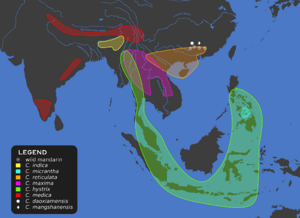Micrantha (citrus) facts for kids
Quick facts for kids Micrantha |
|
|---|---|
| Scientific classification | |
| Kingdom: | |
| (unranked): | |
| (unranked): | |
| (unranked): | |
| Order: | |
| Family: | |
| Genus: | |
| Species: |
C. hystrix
|
| Binomial name | |
| Citrus hystrix |
|
| Synonyms | |
|
Citrus westeri Tanaka |
|
The micrantha is a type of wild citrus fruit. It belongs to the "papeda" group of citrus plants. You can find it growing naturally in the southern Philippines, especially on the islands of Cebu and Bohol.
Scientists recognize two main types, or varieties, of micrantha. One is called small-flowered papeda (C. hystrix var. micrantha), which locals call biasong. The other is the small-fruited papeda (C. hystrix var. microcarpa), known as samuyao.
For a long time, micrantha was thought to be its own separate species, C. micrantha. However, many scientists now believe it's actually a variety of the Kaffir lime (Citrus hystrix). Micrantha is also important because it's one of the original plants that helped create some types of lime fruits we eat today.
Contents
About Micrantha
The micrantha plant was first described to Western scientists in 1915. This was done by Peter Jansen Wester, who worked for the Philippine Bureau of Agriculture.
Biasong: The Small-Flowered Papeda
Peter Jansen Wester collected ripe biasong fruits from islands like Cebu, Bohol, Dumaguete, and Negros. He also found them in the Zamboanga and Misamis provinces in Mindanao. He collected fruits all year round, which means the plant produces fruit continuously.
Biasong plants have small flowers, which is why they are called "small-flowered." Their fruits are oblong-shaped and have few sections inside. People in the Philippines did not usually eat biasong fruits. Instead, they used them for washing hair. This plant was not very important for the economy.
The biasong tree can grow quite tall, reaching about 25 to 30 feet (7.5 to 9 meters). Its leaves are about 3.5 to 4.7 inches (9 to 12 cm) long and 1 to 1.5 inches (2.7 to 4.0 cm) wide. They are broadly oval-shaped with wavy edges. The leaf stems, called petioles, are very wide, sometimes even wider than the leaf itself!
The flowers are small, about half an inch (12 to 13 mm) across. They are white with a thin purple edge and have four petals. They grow in small clusters of two to five flowers. The fruits are oval to oblong, about 2 to 2.7 inches (5 to 7 cm) long. They weigh around 1 ounce (26 grams). The skin is thick and lemon-yellow, and it can be smooth or slightly bumpy. The inside pulp is juicy, grayish, and very sour. The fruits have many flat, pointed seeds.
Samuyao: The Small-Fruited Papeda
Wester also collected ripe samuyao fruits from farms in Cebu and Bohol. He found them in June and from November to February. Samuyao trees are smaller than biasong trees, growing up to about 15 feet (4.5 meters) tall. They have small, thin leaves and flowers that are similar in size to biasong flowers.
The samuyao fruit is very small, only about 0.6 to 0.8 inches (15–20 mm) across. It is likely the smallest fruit in the entire citrus family! Wester also noted a slightly stronger type called "samuyao-sa-amoo" in Bohol, which had slightly larger fruits.
The samuyao tree is like a shrub, about 15 feet (4.5 meters) tall, with thin branches and small, weak thorns. Its leaves are 2 to 3 inches (55 to 80 mm) long and 0.8 to 1 inch (20 to 25 mm) wide. They are oval-shaped, thin, and have a distinct smell. The leaf stems are wide, about half the size of the leaf blade.
The flowers grow in small clusters of 2 to 7. They are tiny, about 0.2 to 0.3 inches (5 to 9 mm) across, and white with a hint of purple. The fruit is round, 0.6 to 0.8 inches (15 to 20 mm) in diameter. It has a wrinkly top and a bumpy, greenish-yellow surface. The skin is very thin. The pulp inside is juicy, sour, and bitter, with a strong smell. The seeds are small and flat.
A clear, strong-smelling oil can be made from the samuyao peel. Women in the areas where it grows have used this oil to make their hair smell nice.
Is Micrantha Safe to Touch?
Micrantha contains a lot of a chemical called bergapten. This chemical is known to cause problems when it touches your skin and then your skin is exposed to sunlight. This reaction is called phytophotodermatitis. It can cause a severe skin rash or inflammation.
Out of 61 different types of citrus plants tested, micrantha had the highest amount of bergapten. It had almost twice as much as the bergamot orange, whose oil is known to cause skin reactions in sunlight. So, if you ever handle micrantha, it's a good idea to wash your hands afterward, especially before going out in the sun.
Micrantha's Family Tree: Hybrids
A "hybrid" is a new plant created when two different parent plants are crossed. The micrantha has been a parent to several well-known citrus fruits:
- The Key lime (Citrus aurantifolia) is a hybrid of the micrantha and the citron.
- The Key lime itself was then crossed with a lemon to create the Persian lime (C. latifolia).
- Some other citrus fruits called "lumias" are also direct hybrids of micrantha and citron. An example is the Pomme d'Adam.
- Other lumias, like the Borneo lemons, are even more complex. They are hybrids of micrantha, citron, and pomelo.
- An Indonesian hybrid called nansaran (C. amblycarpa) is a cross between C. hystrix (which micrantha is often grouped with) and C. reticulata.


